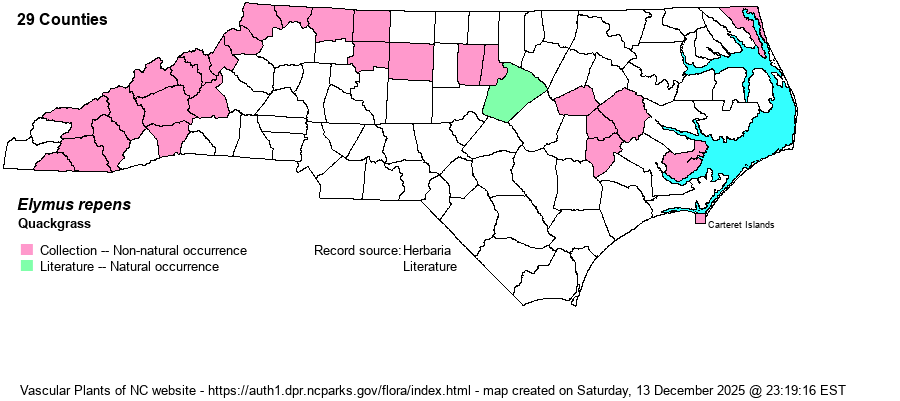| Author | (L.) Gould | |
| Distribution | Mostly Mountains and northern Piedmont; several records from the central Coastal Plain; disjunct to Currituck County (along the Intracoastal Waterway).
Native of Eurasia; widespread in Canada and the U.S. south to SC, AZ. | |
| Abundance | Frequent in the Mountains and northern Piedmont; uncommon in the Coastal Plain, but rare in the northeastern corner. | |
| Habitat | Roadsides, fields, fallow crop fields, meadows, pastures, along railroads, other disturbed ground. | |
| Phenology | Flowering and fruiting June-August. | |
| Identification | Quackgrass is a medium-tall grass (2-3 feet) with a slender, spike-like inflorescence. Each spikelet occurs singly per node (rarely 2), is erect, has 4-7 florets, and which may or may not have a short awn. Each spikelet is turned so that the broad side faces the stem. At a distance it can easily be mistaken for Lolium, whose spikelets are turned so that the narrow side faces the stem. | |
| Taxonomic Comments | Long known as Agropyron repens.
Ryegrasses or Wild-ryes (genus Elymus) are noted by their evenly spaced leaves and elongate, terminal inflorescence that recall cultivated rye or wheat. Each floret produces several long, skinny awns (shortest in E. virginicus sensu stricto). Identification of some species requires a dissecting scope or at least a 10x handlens. | |
| Other Common Name(s) | | |
| State Rank | SE? | |
| Global Rank | GNR | |
| State Status | | |
| US Status | | |
| USACE-agcp | FACU link |
| USACE-emp | FACU link |

